International Marketing: Strategies, Market Entry, Mix, and Structure
VerifiedAdded on 2024/05/23
|22
|5369
|169
Report
AI Summary
This report provides a comprehensive overview of international marketing, covering key concepts, market entry strategies, and the global versus local debate. It examines the rationale for organizations to market internationally, various routes to market, and criteria for selecting international markets. The report evaluates different market entry strategies, including their advantages and disadvantages, and discusses organizational adaptation in international contexts. It also analyzes the marketing mix in different international contexts, explores various international marketing approaches, and provides recommendations on how organizations should be structured to maximize opportunities in the international market. This student-contributed document is available on Desklib, a platform offering a wide range of study tools and resources for students.
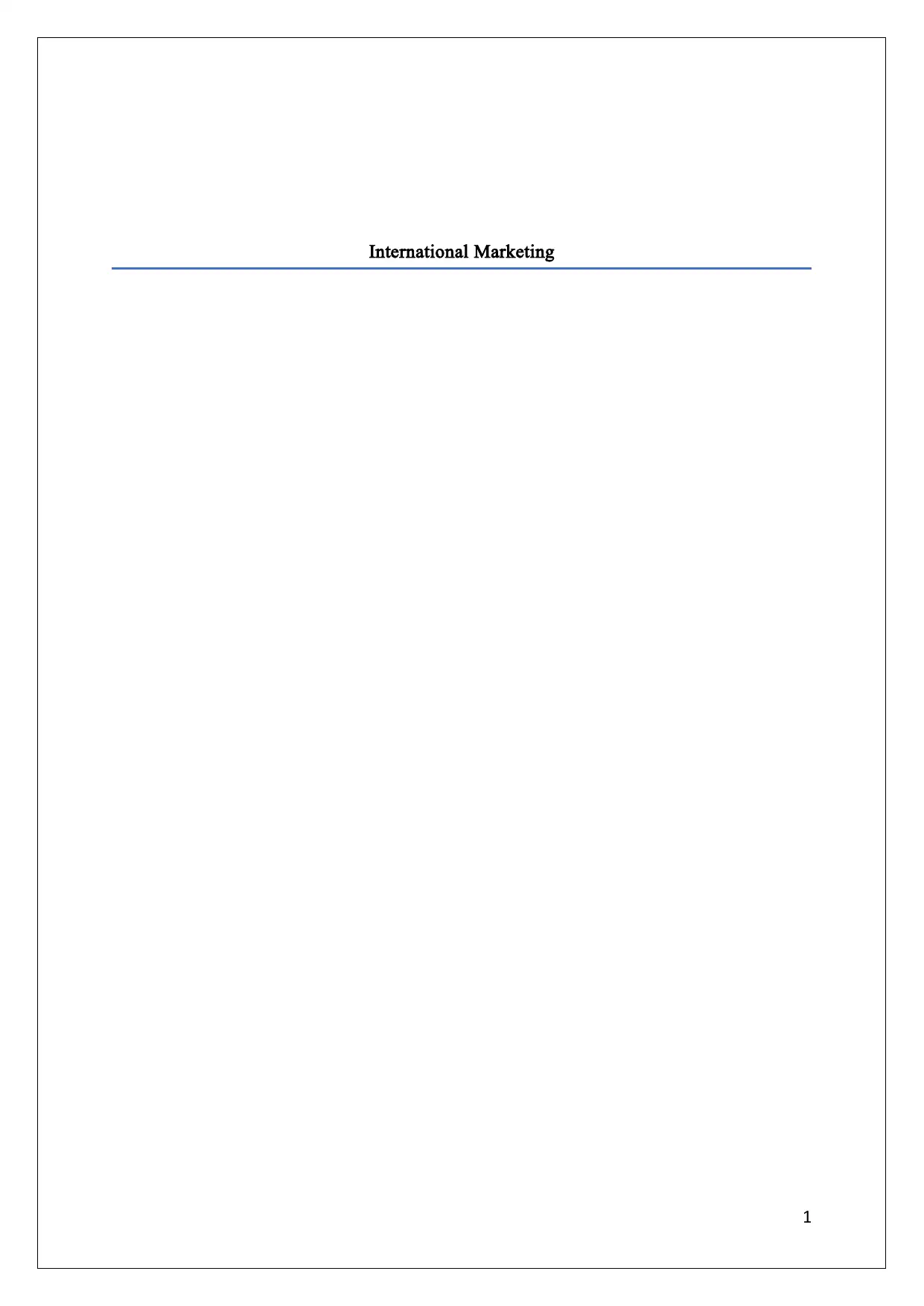
International Marketing
1
1
Paraphrase This Document
Need a fresh take? Get an instant paraphrase of this document with our AI Paraphraser
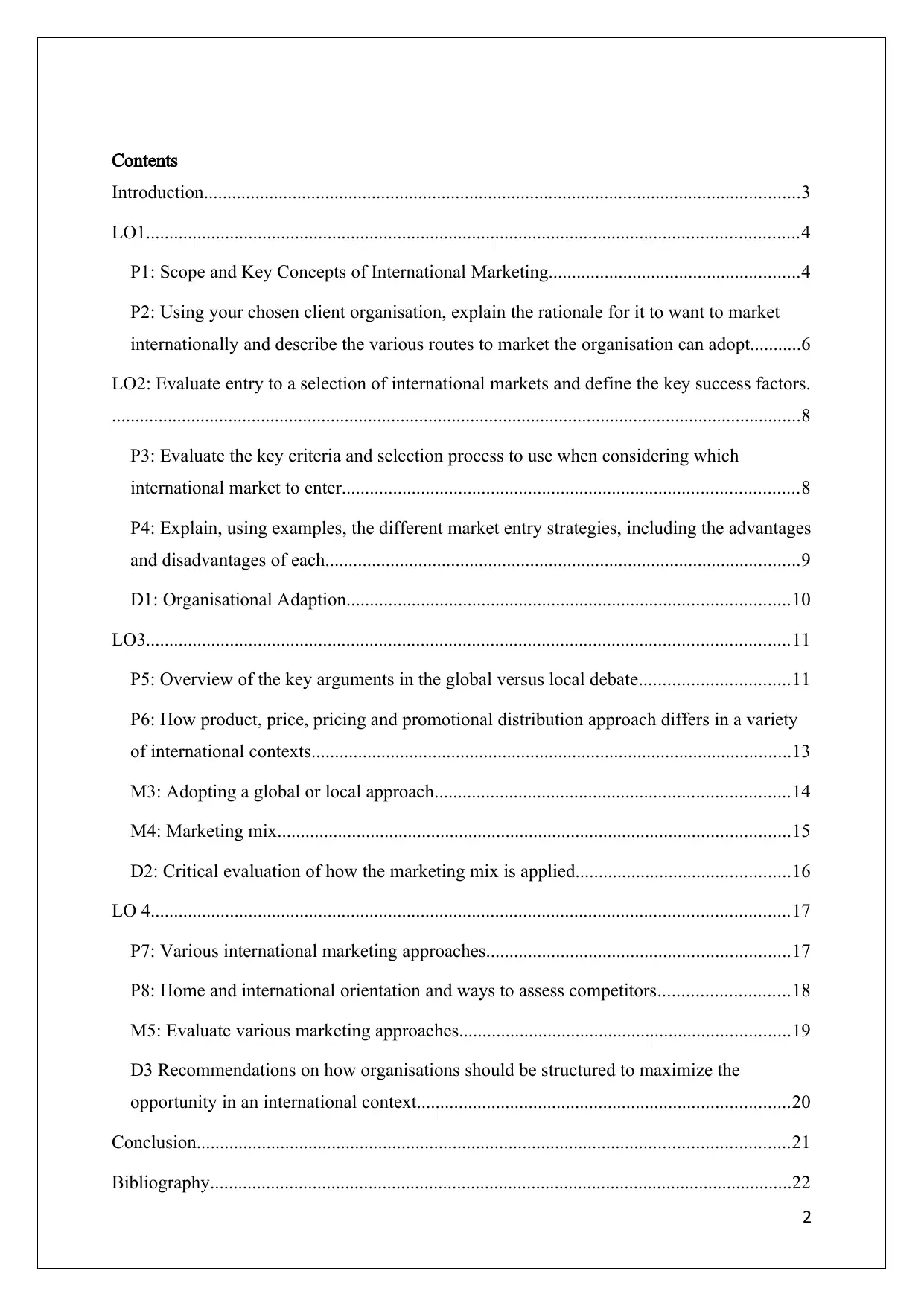
Contents
Introduction................................................................................................................................3
LO1............................................................................................................................................4
P1: Scope and Key Concepts of International Marketing......................................................4
P2: Using your chosen client organisation, explain the rationale for it to want to market
internationally and describe the various routes to market the organisation can adopt...........6
LO2: Evaluate entry to a selection of international markets and define the key success factors.
....................................................................................................................................................8
P3: Evaluate the key criteria and selection process to use when considering which
international market to enter..................................................................................................8
P4: Explain, using examples, the different market entry strategies, including the advantages
and disadvantages of each......................................................................................................9
D1: Organisational Adaption...............................................................................................10
LO3..........................................................................................................................................11
P5: Overview of the key arguments in the global versus local debate................................11
P6: How product, price, pricing and promotional distribution approach differs in a variety
of international contexts.......................................................................................................13
M3: Adopting a global or local approach............................................................................14
M4: Marketing mix..............................................................................................................15
D2: Critical evaluation of how the marketing mix is applied..............................................16
LO 4.........................................................................................................................................17
P7: Various international marketing approaches.................................................................17
P8: Home and international orientation and ways to assess competitors............................18
M5: Evaluate various marketing approaches.......................................................................19
D3 Recommendations on how organisations should be structured to maximize the
opportunity in an international context................................................................................20
Conclusion...............................................................................................................................21
Bibliography.............................................................................................................................22
2
Introduction................................................................................................................................3
LO1............................................................................................................................................4
P1: Scope and Key Concepts of International Marketing......................................................4
P2: Using your chosen client organisation, explain the rationale for it to want to market
internationally and describe the various routes to market the organisation can adopt...........6
LO2: Evaluate entry to a selection of international markets and define the key success factors.
....................................................................................................................................................8
P3: Evaluate the key criteria and selection process to use when considering which
international market to enter..................................................................................................8
P4: Explain, using examples, the different market entry strategies, including the advantages
and disadvantages of each......................................................................................................9
D1: Organisational Adaption...............................................................................................10
LO3..........................................................................................................................................11
P5: Overview of the key arguments in the global versus local debate................................11
P6: How product, price, pricing and promotional distribution approach differs in a variety
of international contexts.......................................................................................................13
M3: Adopting a global or local approach............................................................................14
M4: Marketing mix..............................................................................................................15
D2: Critical evaluation of how the marketing mix is applied..............................................16
LO 4.........................................................................................................................................17
P7: Various international marketing approaches.................................................................17
P8: Home and international orientation and ways to assess competitors............................18
M5: Evaluate various marketing approaches.......................................................................19
D3 Recommendations on how organisations should be structured to maximize the
opportunity in an international context................................................................................20
Conclusion...............................................................................................................................21
Bibliography.............................................................................................................................22
2
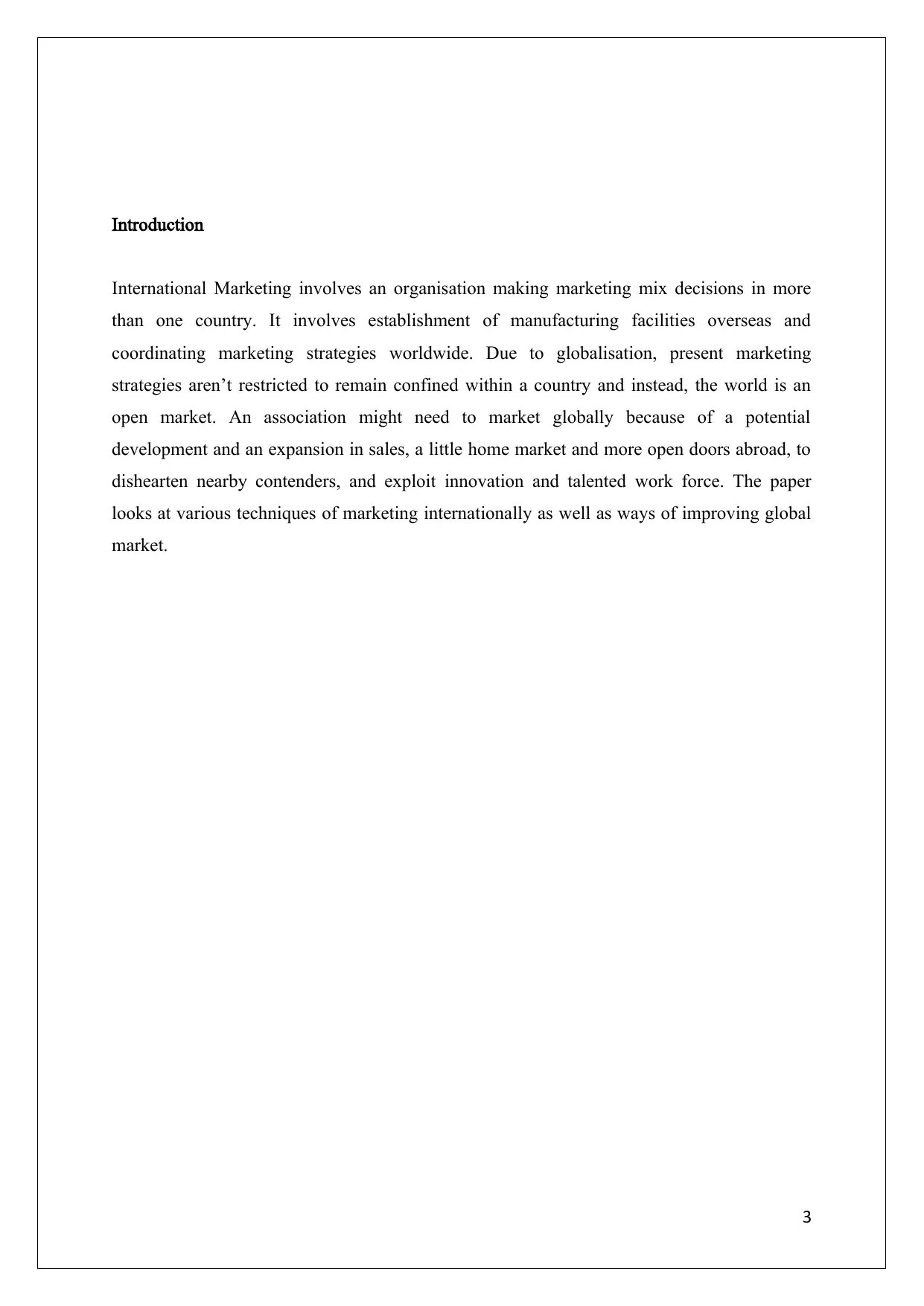
Introduction
International Marketing involves an organisation making marketing mix decisions in more
than one country. It involves establishment of manufacturing facilities overseas and
coordinating marketing strategies worldwide. Due to globalisation, present marketing
strategies aren’t restricted to remain confined within a country and instead, the world is an
open market. An association might need to market globally because of a potential
development and an expansion in sales, a little home market and more open doors abroad, to
dishearten nearby contenders, and exploit innovation and talented work force. The paper
looks at various techniques of marketing internationally as well as ways of improving global
market.
3
International Marketing involves an organisation making marketing mix decisions in more
than one country. It involves establishment of manufacturing facilities overseas and
coordinating marketing strategies worldwide. Due to globalisation, present marketing
strategies aren’t restricted to remain confined within a country and instead, the world is an
open market. An association might need to market globally because of a potential
development and an expansion in sales, a little home market and more open doors abroad, to
dishearten nearby contenders, and exploit innovation and talented work force. The paper
looks at various techniques of marketing internationally as well as ways of improving global
market.
3
⊘ This is a preview!⊘
Do you want full access?
Subscribe today to unlock all pages.

Trusted by 1+ million students worldwide
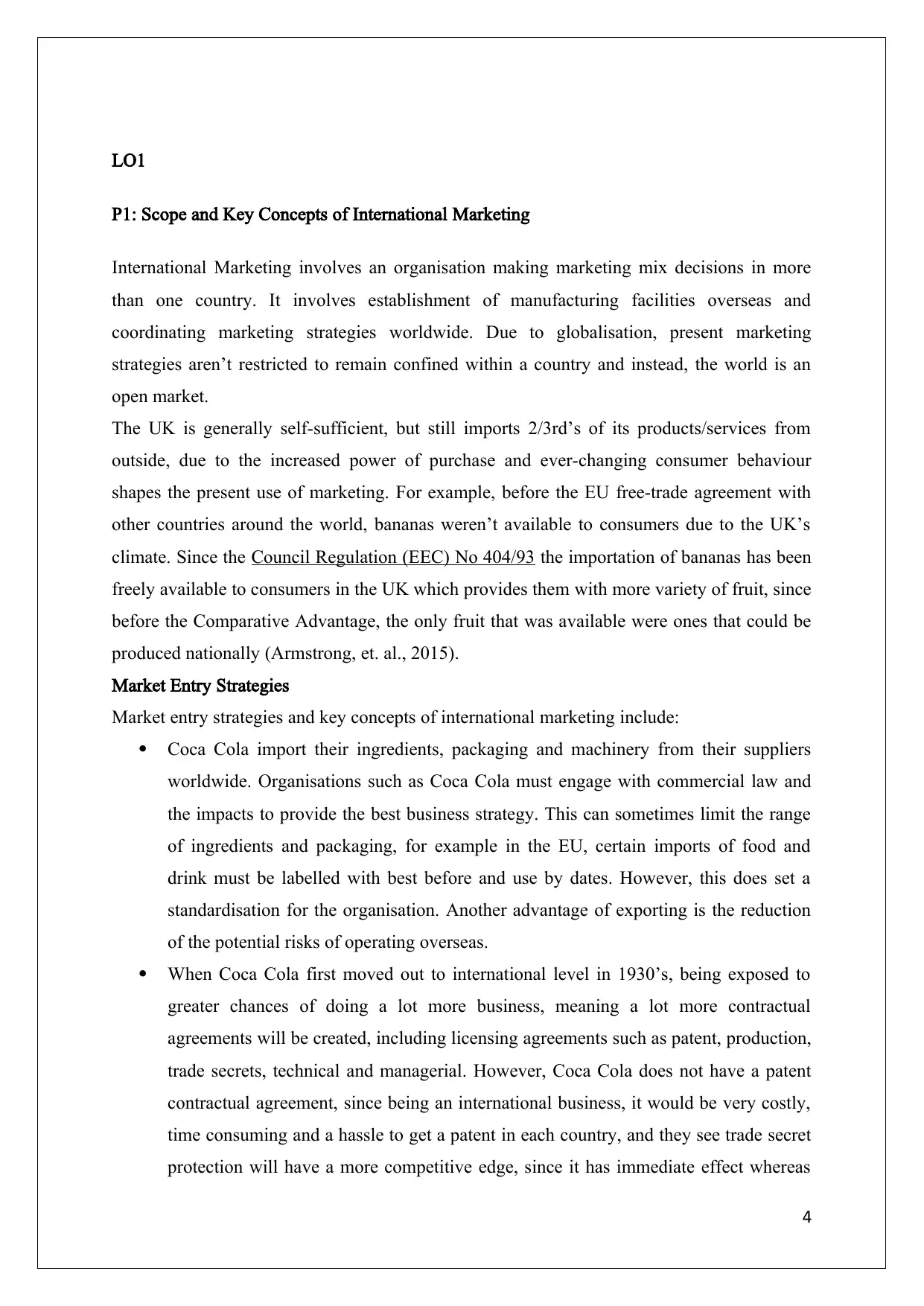
LO1
P1: Scope and Key Concepts of International Marketing
International Marketing involves an organisation making marketing mix decisions in more
than one country. It involves establishment of manufacturing facilities overseas and
coordinating marketing strategies worldwide. Due to globalisation, present marketing
strategies aren’t restricted to remain confined within a country and instead, the world is an
open market.
The UK is generally self-sufficient, but still imports 2/3rd’s of its products/services from
outside, due to the increased power of purchase and ever-changing consumer behaviour
shapes the present use of marketing. For example, before the EU free-trade agreement with
other countries around the world, bananas weren’t available to consumers due to the UK’s
climate. Since the Council Regulation (EEC) No 404/93 the importation of bananas has been
freely available to consumers in the UK which provides them with more variety of fruit, since
before the Comparative Advantage, the only fruit that was available were ones that could be
produced nationally (Armstrong, et. al., 2015).
Market Entry Strategies
Market entry strategies and key concepts of international marketing include:
Coca Cola import their ingredients, packaging and machinery from their suppliers
worldwide. Organisations such as Coca Cola must engage with commercial law and
the impacts to provide the best business strategy. This can sometimes limit the range
of ingredients and packaging, for example in the EU, certain imports of food and
drink must be labelled with best before and use by dates. However, this does set a
standardisation for the organisation. Another advantage of exporting is the reduction
of the potential risks of operating overseas.
When Coca Cola first moved out to international level in 1930’s, being exposed to
greater chances of doing a lot more business, meaning a lot more contractual
agreements will be created, including licensing agreements such as patent, production,
trade secrets, technical and managerial. However, Coca Cola does not have a patent
contractual agreement, since being an international business, it would be very costly,
time consuming and a hassle to get a patent in each country, and they see trade secret
protection will have a more competitive edge, since it has immediate effect whereas
4
P1: Scope and Key Concepts of International Marketing
International Marketing involves an organisation making marketing mix decisions in more
than one country. It involves establishment of manufacturing facilities overseas and
coordinating marketing strategies worldwide. Due to globalisation, present marketing
strategies aren’t restricted to remain confined within a country and instead, the world is an
open market.
The UK is generally self-sufficient, but still imports 2/3rd’s of its products/services from
outside, due to the increased power of purchase and ever-changing consumer behaviour
shapes the present use of marketing. For example, before the EU free-trade agreement with
other countries around the world, bananas weren’t available to consumers due to the UK’s
climate. Since the Council Regulation (EEC) No 404/93 the importation of bananas has been
freely available to consumers in the UK which provides them with more variety of fruit, since
before the Comparative Advantage, the only fruit that was available were ones that could be
produced nationally (Armstrong, et. al., 2015).
Market Entry Strategies
Market entry strategies and key concepts of international marketing include:
Coca Cola import their ingredients, packaging and machinery from their suppliers
worldwide. Organisations such as Coca Cola must engage with commercial law and
the impacts to provide the best business strategy. This can sometimes limit the range
of ingredients and packaging, for example in the EU, certain imports of food and
drink must be labelled with best before and use by dates. However, this does set a
standardisation for the organisation. Another advantage of exporting is the reduction
of the potential risks of operating overseas.
When Coca Cola first moved out to international level in 1930’s, being exposed to
greater chances of doing a lot more business, meaning a lot more contractual
agreements will be created, including licensing agreements such as patent, production,
trade secrets, technical and managerial. However, Coca Cola does not have a patent
contractual agreement, since being an international business, it would be very costly,
time consuming and a hassle to get a patent in each country, and they see trade secret
protection will have a more competitive edge, since it has immediate effect whereas
4
Paraphrase This Document
Need a fresh take? Get an instant paraphrase of this document with our AI Paraphraser
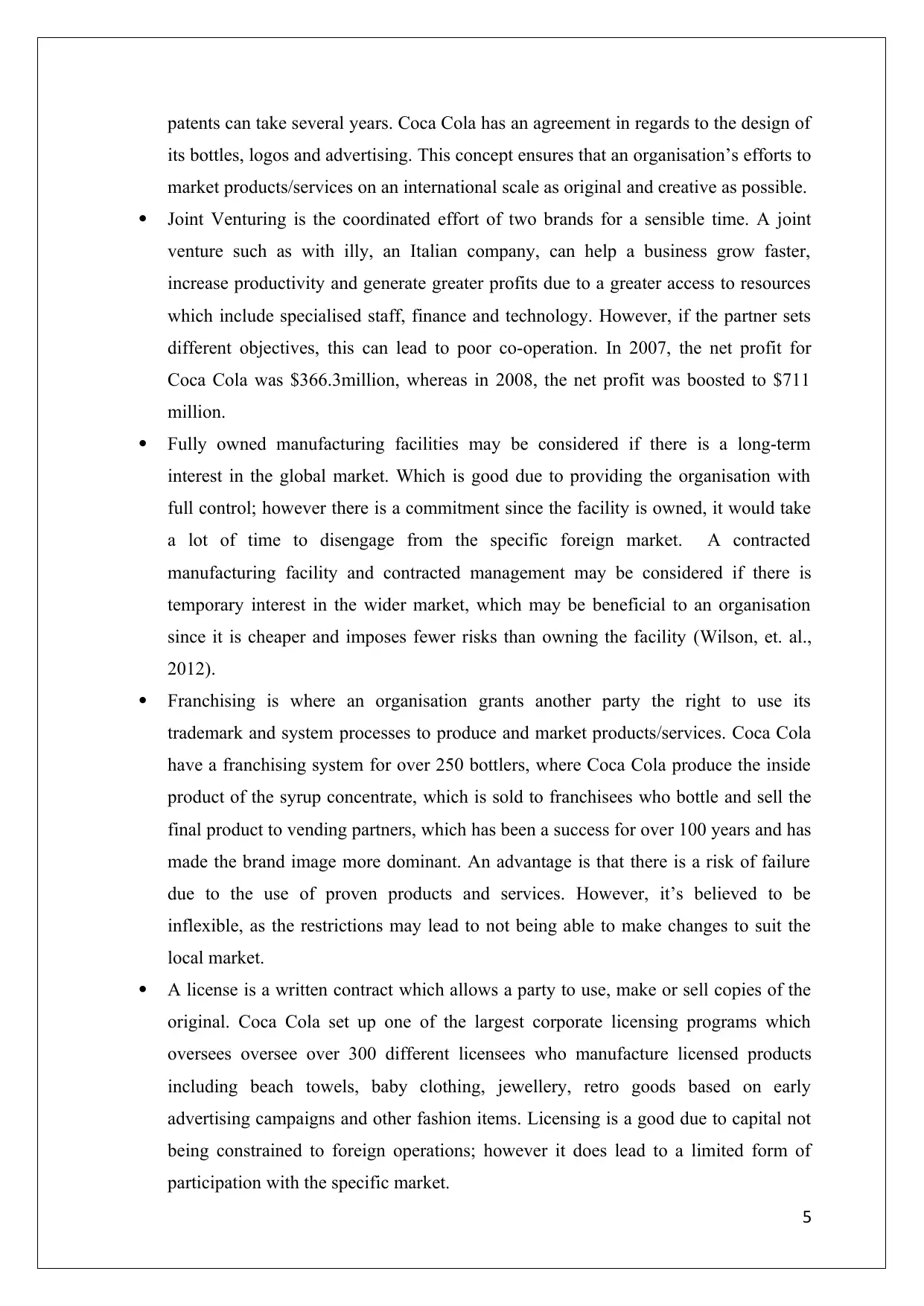
patents can take several years. Coca Cola has an agreement in regards to the design of
its bottles, logos and advertising. This concept ensures that an organisation’s efforts to
market products/services on an international scale as original and creative as possible.
Joint Venturing is the coordinated effort of two brands for a sensible time. A joint
venture such as with illy, an Italian company, can help a business grow faster,
increase productivity and generate greater profits due to a greater access to resources
which include specialised staff, finance and technology. However, if the partner sets
different objectives, this can lead to poor co-operation. In 2007, the net profit for
Coca Cola was $366.3million, whereas in 2008, the net profit was boosted to $711
million.
Fully owned manufacturing facilities may be considered if there is a long-term
interest in the global market. Which is good due to providing the organisation with
full control; however there is a commitment since the facility is owned, it would take
a lot of time to disengage from the specific foreign market. A contracted
manufacturing facility and contracted management may be considered if there is
temporary interest in the wider market, which may be beneficial to an organisation
since it is cheaper and imposes fewer risks than owning the facility (Wilson, et. al.,
2012).
Franchising is where an organisation grants another party the right to use its
trademark and system processes to produce and market products/services. Coca Cola
have a franchising system for over 250 bottlers, where Coca Cola produce the inside
product of the syrup concentrate, which is sold to franchisees who bottle and sell the
final product to vending partners, which has been a success for over 100 years and has
made the brand image more dominant. An advantage is that there is a risk of failure
due to the use of proven products and services. However, it’s believed to be
inflexible, as the restrictions may lead to not being able to make changes to suit the
local market.
A license is a written contract which allows a party to use, make or sell copies of the
original. Coca Cola set up one of the largest corporate licensing programs which
oversees oversee over 300 different licensees who manufacture licensed products
including beach towels, baby clothing, jewellery, retro goods based on early
advertising campaigns and other fashion items. Licensing is a good due to capital not
being constrained to foreign operations; however it does lead to a limited form of
participation with the specific market.
5
its bottles, logos and advertising. This concept ensures that an organisation’s efforts to
market products/services on an international scale as original and creative as possible.
Joint Venturing is the coordinated effort of two brands for a sensible time. A joint
venture such as with illy, an Italian company, can help a business grow faster,
increase productivity and generate greater profits due to a greater access to resources
which include specialised staff, finance and technology. However, if the partner sets
different objectives, this can lead to poor co-operation. In 2007, the net profit for
Coca Cola was $366.3million, whereas in 2008, the net profit was boosted to $711
million.
Fully owned manufacturing facilities may be considered if there is a long-term
interest in the global market. Which is good due to providing the organisation with
full control; however there is a commitment since the facility is owned, it would take
a lot of time to disengage from the specific foreign market. A contracted
manufacturing facility and contracted management may be considered if there is
temporary interest in the wider market, which may be beneficial to an organisation
since it is cheaper and imposes fewer risks than owning the facility (Wilson, et. al.,
2012).
Franchising is where an organisation grants another party the right to use its
trademark and system processes to produce and market products/services. Coca Cola
have a franchising system for over 250 bottlers, where Coca Cola produce the inside
product of the syrup concentrate, which is sold to franchisees who bottle and sell the
final product to vending partners, which has been a success for over 100 years and has
made the brand image more dominant. An advantage is that there is a risk of failure
due to the use of proven products and services. However, it’s believed to be
inflexible, as the restrictions may lead to not being able to make changes to suit the
local market.
A license is a written contract which allows a party to use, make or sell copies of the
original. Coca Cola set up one of the largest corporate licensing programs which
oversees oversee over 300 different licensees who manufacture licensed products
including beach towels, baby clothing, jewellery, retro goods based on early
advertising campaigns and other fashion items. Licensing is a good due to capital not
being constrained to foreign operations; however it does lead to a limited form of
participation with the specific market.
5
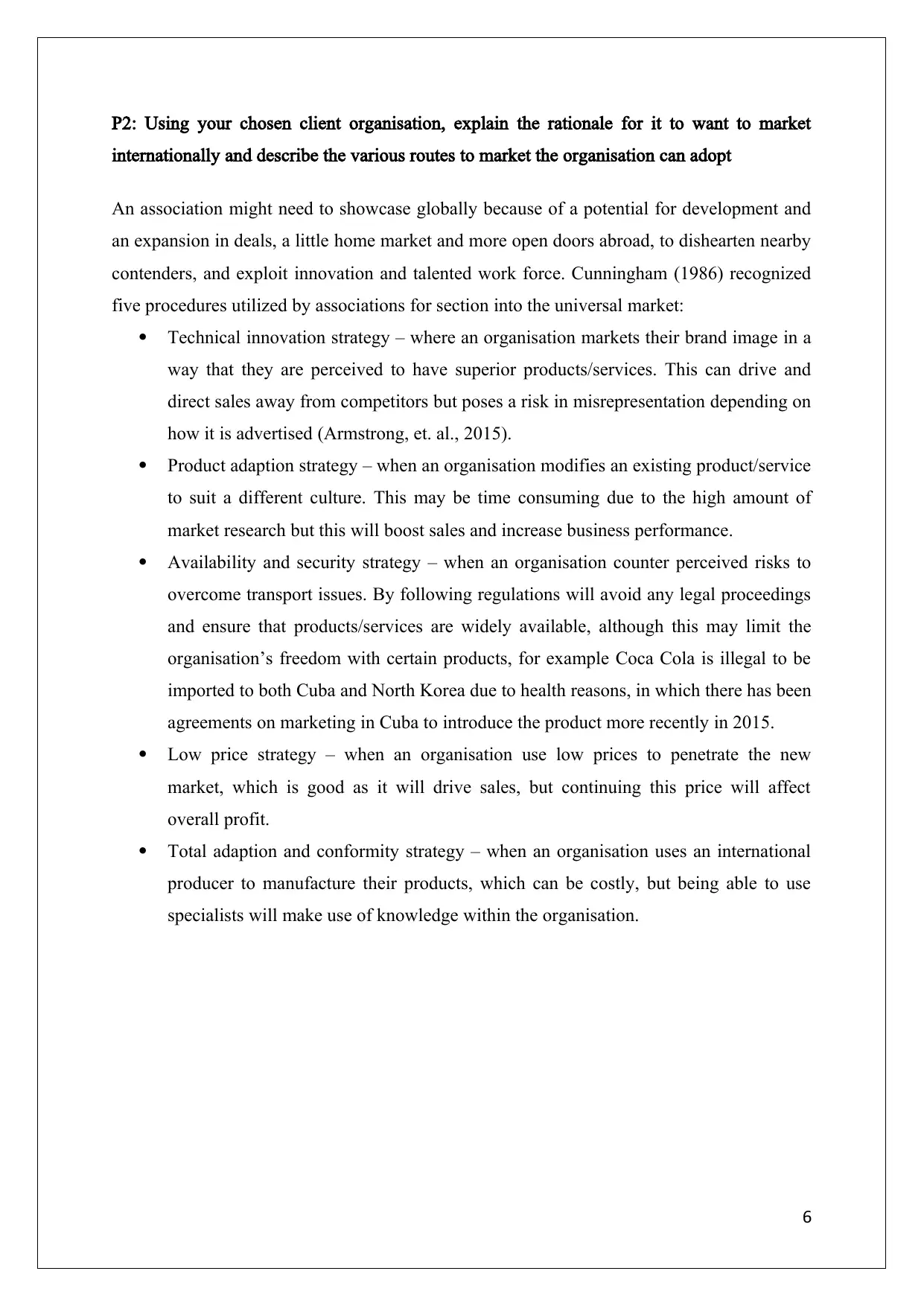
P2: Using your chosen client organisation, explain the rationale for it to want to market
internationally and describe the various routes to market the organisation can adopt
An association might need to showcase globally because of a potential for development and
an expansion in deals, a little home market and more open doors abroad, to dishearten nearby
contenders, and exploit innovation and talented work force. Cunningham (1986) recognized
five procedures utilized by associations for section into the universal market:
Technical innovation strategy – where an organisation markets their brand image in a
way that they are perceived to have superior products/services. This can drive and
direct sales away from competitors but poses a risk in misrepresentation depending on
how it is advertised (Armstrong, et. al., 2015).
Product adaption strategy – when an organisation modifies an existing product/service
to suit a different culture. This may be time consuming due to the high amount of
market research but this will boost sales and increase business performance.
Availability and security strategy – when an organisation counter perceived risks to
overcome transport issues. By following regulations will avoid any legal proceedings
and ensure that products/services are widely available, although this may limit the
organisation’s freedom with certain products, for example Coca Cola is illegal to be
imported to both Cuba and North Korea due to health reasons, in which there has been
agreements on marketing in Cuba to introduce the product more recently in 2015.
Low price strategy – when an organisation use low prices to penetrate the new
market, which is good as it will drive sales, but continuing this price will affect
overall profit.
Total adaption and conformity strategy – when an organisation uses an international
producer to manufacture their products, which can be costly, but being able to use
specialists will make use of knowledge within the organisation.
6
internationally and describe the various routes to market the organisation can adopt
An association might need to showcase globally because of a potential for development and
an expansion in deals, a little home market and more open doors abroad, to dishearten nearby
contenders, and exploit innovation and talented work force. Cunningham (1986) recognized
five procedures utilized by associations for section into the universal market:
Technical innovation strategy – where an organisation markets their brand image in a
way that they are perceived to have superior products/services. This can drive and
direct sales away from competitors but poses a risk in misrepresentation depending on
how it is advertised (Armstrong, et. al., 2015).
Product adaption strategy – when an organisation modifies an existing product/service
to suit a different culture. This may be time consuming due to the high amount of
market research but this will boost sales and increase business performance.
Availability and security strategy – when an organisation counter perceived risks to
overcome transport issues. By following regulations will avoid any legal proceedings
and ensure that products/services are widely available, although this may limit the
organisation’s freedom with certain products, for example Coca Cola is illegal to be
imported to both Cuba and North Korea due to health reasons, in which there has been
agreements on marketing in Cuba to introduce the product more recently in 2015.
Low price strategy – when an organisation use low prices to penetrate the new
market, which is good as it will drive sales, but continuing this price will affect
overall profit.
Total adaption and conformity strategy – when an organisation uses an international
producer to manufacture their products, which can be costly, but being able to use
specialists will make use of knowledge within the organisation.
6
⊘ This is a preview!⊘
Do you want full access?
Subscribe today to unlock all pages.

Trusted by 1+ million students worldwide
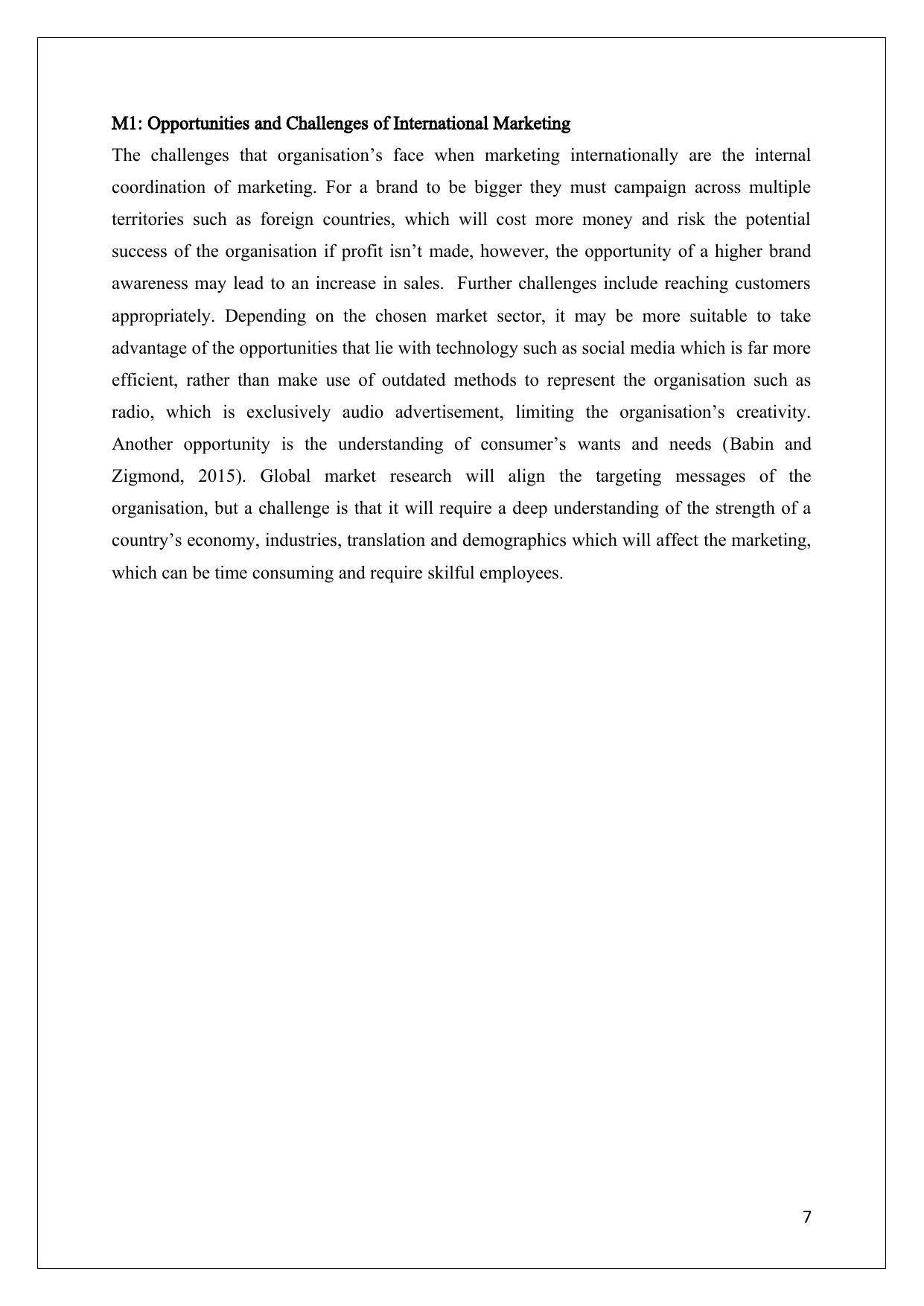
M1: Opportunities and Challenges of International Marketing
The challenges that organisation’s face when marketing internationally are the internal
coordination of marketing. For a brand to be bigger they must campaign across multiple
territories such as foreign countries, which will cost more money and risk the potential
success of the organisation if profit isn’t made, however, the opportunity of a higher brand
awareness may lead to an increase in sales. Further challenges include reaching customers
appropriately. Depending on the chosen market sector, it may be more suitable to take
advantage of the opportunities that lie with technology such as social media which is far more
efficient, rather than make use of outdated methods to represent the organisation such as
radio, which is exclusively audio advertisement, limiting the organisation’s creativity.
Another opportunity is the understanding of consumer’s wants and needs (Babin and
Zigmond, 2015). Global market research will align the targeting messages of the
organisation, but a challenge is that it will require a deep understanding of the strength of a
country’s economy, industries, translation and demographics which will affect the marketing,
which can be time consuming and require skilful employees.
7
The challenges that organisation’s face when marketing internationally are the internal
coordination of marketing. For a brand to be bigger they must campaign across multiple
territories such as foreign countries, which will cost more money and risk the potential
success of the organisation if profit isn’t made, however, the opportunity of a higher brand
awareness may lead to an increase in sales. Further challenges include reaching customers
appropriately. Depending on the chosen market sector, it may be more suitable to take
advantage of the opportunities that lie with technology such as social media which is far more
efficient, rather than make use of outdated methods to represent the organisation such as
radio, which is exclusively audio advertisement, limiting the organisation’s creativity.
Another opportunity is the understanding of consumer’s wants and needs (Babin and
Zigmond, 2015). Global market research will align the targeting messages of the
organisation, but a challenge is that it will require a deep understanding of the strength of a
country’s economy, industries, translation and demographics which will affect the marketing,
which can be time consuming and require skilful employees.
7
Paraphrase This Document
Need a fresh take? Get an instant paraphrase of this document with our AI Paraphraser
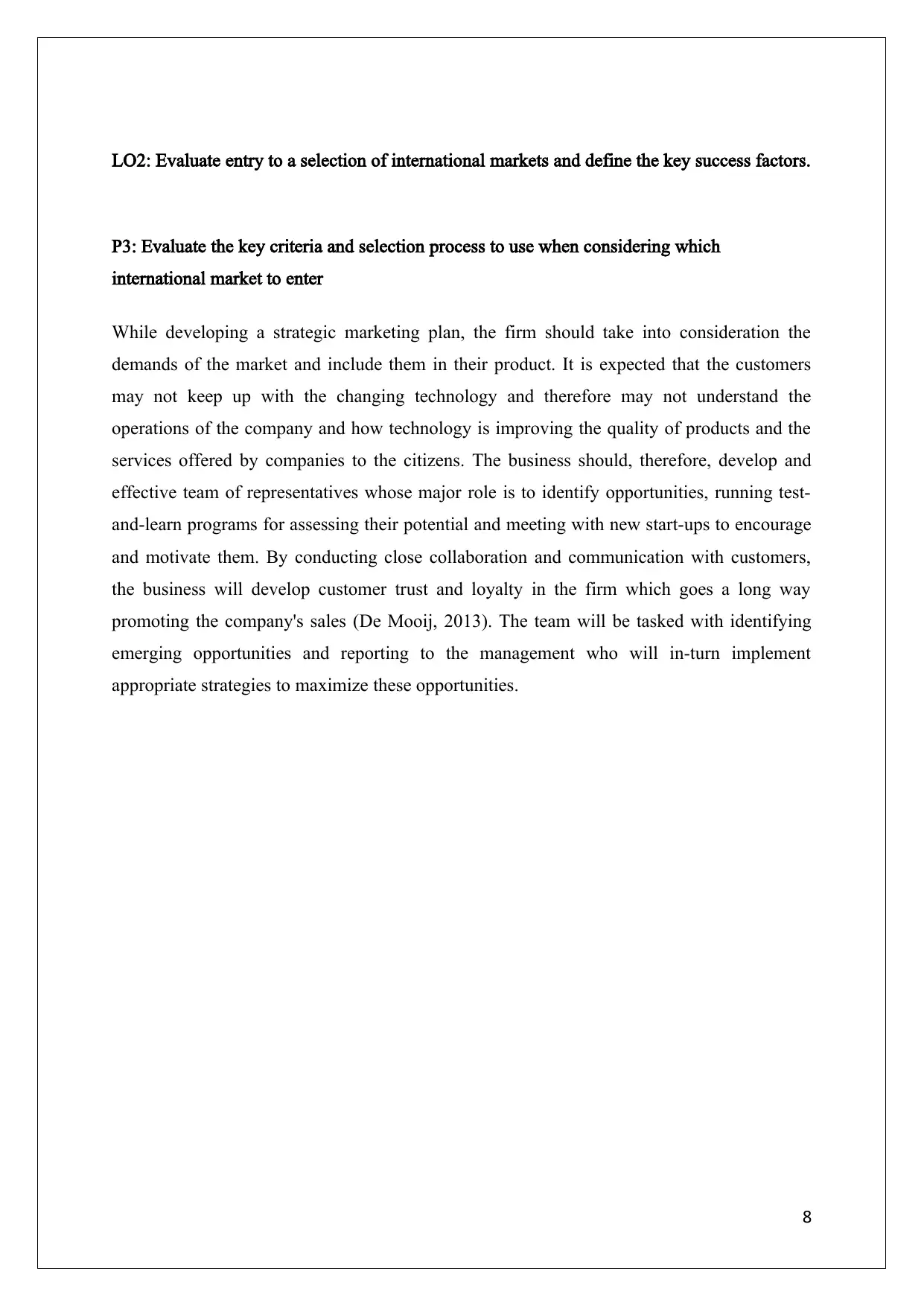
LO2: Evaluate entry to a selection of international markets and define the key success factors.
P3: Evaluate the key criteria and selection process to use when considering which
international market to enter
While developing a strategic marketing plan, the firm should take into consideration the
demands of the market and include them in their product. It is expected that the customers
may not keep up with the changing technology and therefore may not understand the
operations of the company and how technology is improving the quality of products and the
services offered by companies to the citizens. The business should, therefore, develop and
effective team of representatives whose major role is to identify opportunities, running test-
and-learn programs for assessing their potential and meeting with new start-ups to encourage
and motivate them. By conducting close collaboration and communication with customers,
the business will develop customer trust and loyalty in the firm which goes a long way
promoting the company's sales (De Mooij, 2013). The team will be tasked with identifying
emerging opportunities and reporting to the management who will in-turn implement
appropriate strategies to maximize these opportunities.
8
P3: Evaluate the key criteria and selection process to use when considering which
international market to enter
While developing a strategic marketing plan, the firm should take into consideration the
demands of the market and include them in their product. It is expected that the customers
may not keep up with the changing technology and therefore may not understand the
operations of the company and how technology is improving the quality of products and the
services offered by companies to the citizens. The business should, therefore, develop and
effective team of representatives whose major role is to identify opportunities, running test-
and-learn programs for assessing their potential and meeting with new start-ups to encourage
and motivate them. By conducting close collaboration and communication with customers,
the business will develop customer trust and loyalty in the firm which goes a long way
promoting the company's sales (De Mooij, 2013). The team will be tasked with identifying
emerging opportunities and reporting to the management who will in-turn implement
appropriate strategies to maximize these opportunities.
8
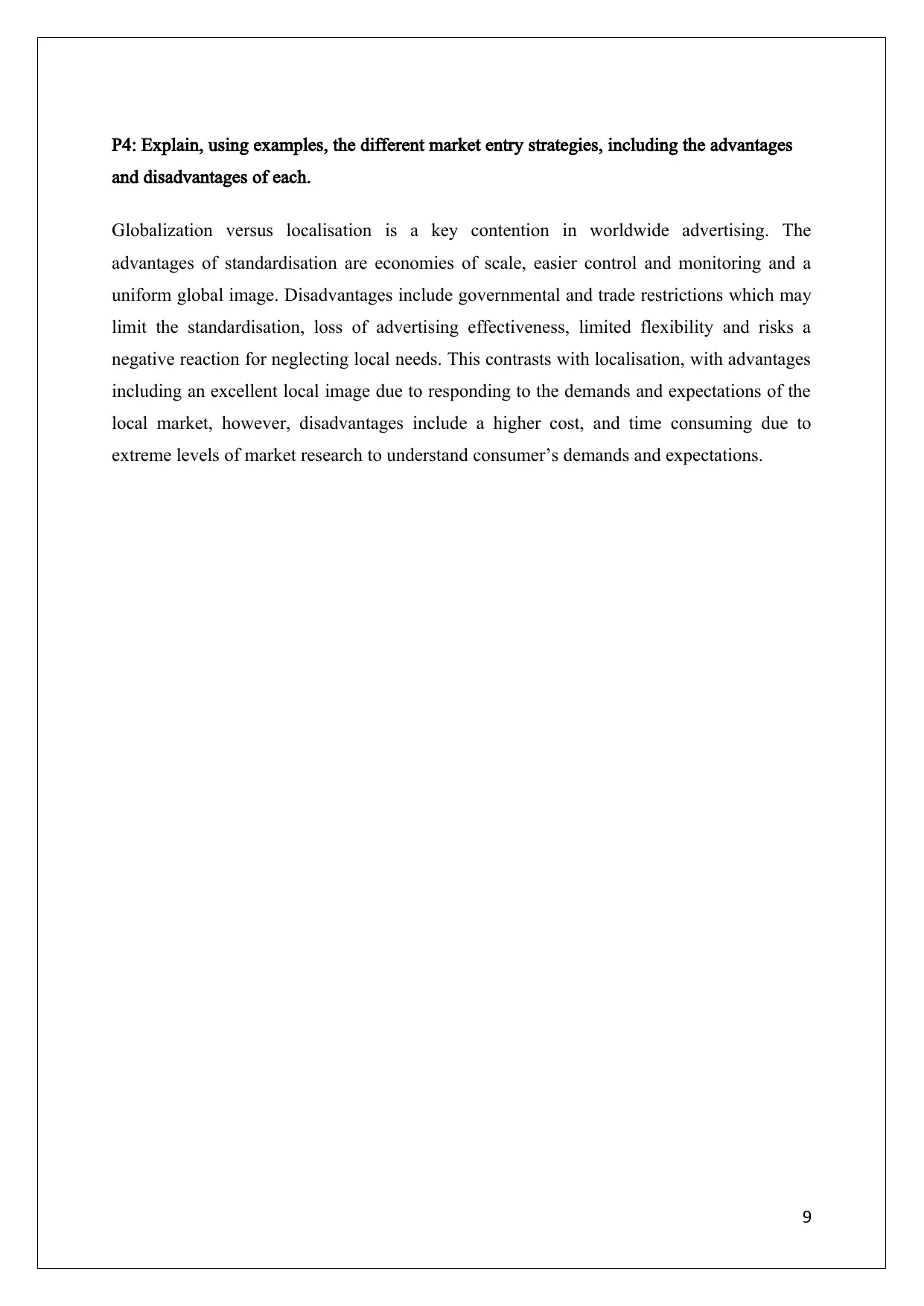
P4: Explain, using examples, the different market entry strategies, including the advantages
and disadvantages of each.
Globalization versus localisation is a key contention in worldwide advertising. The
advantages of standardisation are economies of scale, easier control and monitoring and a
uniform global image. Disadvantages include governmental and trade restrictions which may
limit the standardisation, loss of advertising effectiveness, limited flexibility and risks a
negative reaction for neglecting local needs. This contrasts with localisation, with advantages
including an excellent local image due to responding to the demands and expectations of the
local market, however, disadvantages include a higher cost, and time consuming due to
extreme levels of market research to understand consumer’s demands and expectations.
9
and disadvantages of each.
Globalization versus localisation is a key contention in worldwide advertising. The
advantages of standardisation are economies of scale, easier control and monitoring and a
uniform global image. Disadvantages include governmental and trade restrictions which may
limit the standardisation, loss of advertising effectiveness, limited flexibility and risks a
negative reaction for neglecting local needs. This contrasts with localisation, with advantages
including an excellent local image due to responding to the demands and expectations of the
local market, however, disadvantages include a higher cost, and time consuming due to
extreme levels of market research to understand consumer’s demands and expectations.
9
⊘ This is a preview!⊘
Do you want full access?
Subscribe today to unlock all pages.

Trusted by 1+ million students worldwide
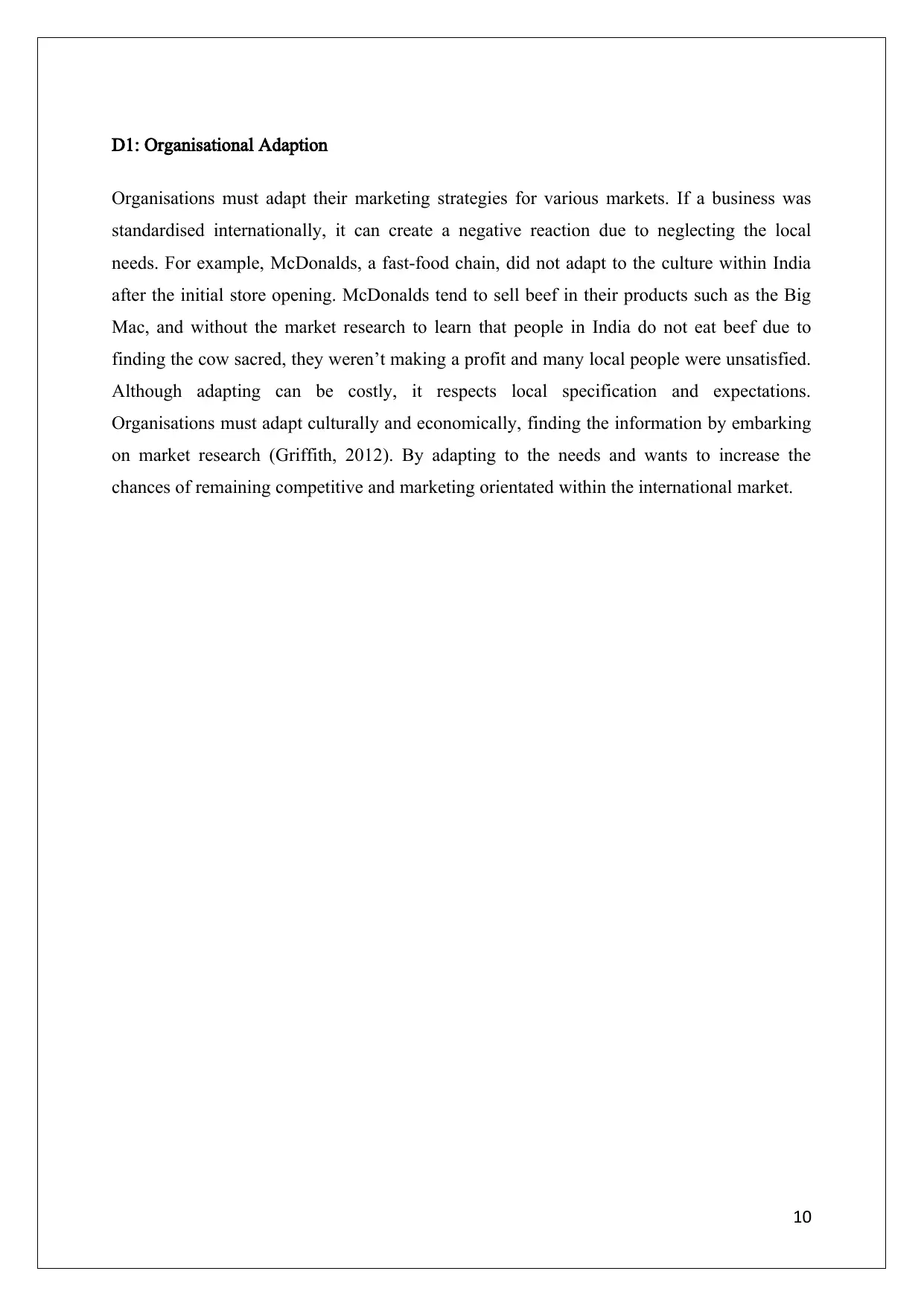
D1: Organisational Adaption
Organisations must adapt their marketing strategies for various markets. If a business was
standardised internationally, it can create a negative reaction due to neglecting the local
needs. For example, McDonalds, a fast-food chain, did not adapt to the culture within India
after the initial store opening. McDonalds tend to sell beef in their products such as the Big
Mac, and without the market research to learn that people in India do not eat beef due to
finding the cow sacred, they weren’t making a profit and many local people were unsatisfied.
Although adapting can be costly, it respects local specification and expectations.
Organisations must adapt culturally and economically, finding the information by embarking
on market research (Griffith, 2012). By adapting to the needs and wants to increase the
chances of remaining competitive and marketing orientated within the international market.
10
Organisations must adapt their marketing strategies for various markets. If a business was
standardised internationally, it can create a negative reaction due to neglecting the local
needs. For example, McDonalds, a fast-food chain, did not adapt to the culture within India
after the initial store opening. McDonalds tend to sell beef in their products such as the Big
Mac, and without the market research to learn that people in India do not eat beef due to
finding the cow sacred, they weren’t making a profit and many local people were unsatisfied.
Although adapting can be costly, it respects local specification and expectations.
Organisations must adapt culturally and economically, finding the information by embarking
on market research (Griffith, 2012). By adapting to the needs and wants to increase the
chances of remaining competitive and marketing orientated within the international market.
10
Paraphrase This Document
Need a fresh take? Get an instant paraphrase of this document with our AI Paraphraser
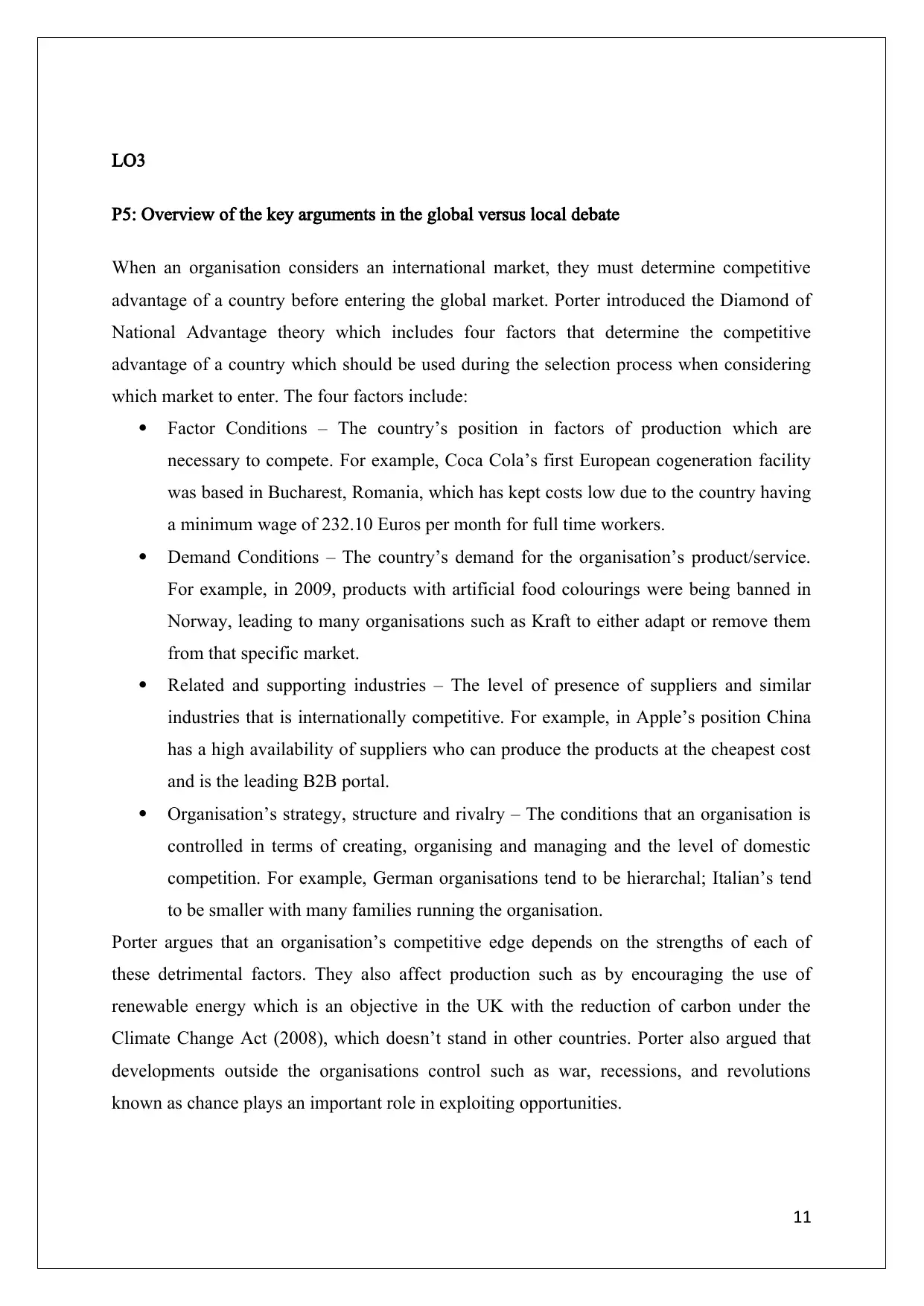
LO3
P5: Overview of the key arguments in the global versus local debate
When an organisation considers an international market, they must determine competitive
advantage of a country before entering the global market. Porter introduced the Diamond of
National Advantage theory which includes four factors that determine the competitive
advantage of a country which should be used during the selection process when considering
which market to enter. The four factors include:
Factor Conditions – The country’s position in factors of production which are
necessary to compete. For example, Coca Cola’s first European cogeneration facility
was based in Bucharest, Romania, which has kept costs low due to the country having
a minimum wage of 232.10 Euros per month for full time workers.
Demand Conditions – The country’s demand for the organisation’s product/service.
For example, in 2009, products with artificial food colourings were being banned in
Norway, leading to many organisations such as Kraft to either adapt or remove them
from that specific market.
Related and supporting industries – The level of presence of suppliers and similar
industries that is internationally competitive. For example, in Apple’s position China
has a high availability of suppliers who can produce the products at the cheapest cost
and is the leading B2B portal.
Organisation’s strategy, structure and rivalry – The conditions that an organisation is
controlled in terms of creating, organising and managing and the level of domestic
competition. For example, German organisations tend to be hierarchal; Italian’s tend
to be smaller with many families running the organisation.
Porter argues that an organisation’s competitive edge depends on the strengths of each of
these detrimental factors. They also affect production such as by encouraging the use of
renewable energy which is an objective in the UK with the reduction of carbon under the
Climate Change Act (2008), which doesn’t stand in other countries. Porter also argued that
developments outside the organisations control such as war, recessions, and revolutions
known as chance plays an important role in exploiting opportunities.
11
P5: Overview of the key arguments in the global versus local debate
When an organisation considers an international market, they must determine competitive
advantage of a country before entering the global market. Porter introduced the Diamond of
National Advantage theory which includes four factors that determine the competitive
advantage of a country which should be used during the selection process when considering
which market to enter. The four factors include:
Factor Conditions – The country’s position in factors of production which are
necessary to compete. For example, Coca Cola’s first European cogeneration facility
was based in Bucharest, Romania, which has kept costs low due to the country having
a minimum wage of 232.10 Euros per month for full time workers.
Demand Conditions – The country’s demand for the organisation’s product/service.
For example, in 2009, products with artificial food colourings were being banned in
Norway, leading to many organisations such as Kraft to either adapt or remove them
from that specific market.
Related and supporting industries – The level of presence of suppliers and similar
industries that is internationally competitive. For example, in Apple’s position China
has a high availability of suppliers who can produce the products at the cheapest cost
and is the leading B2B portal.
Organisation’s strategy, structure and rivalry – The conditions that an organisation is
controlled in terms of creating, organising and managing and the level of domestic
competition. For example, German organisations tend to be hierarchal; Italian’s tend
to be smaller with many families running the organisation.
Porter argues that an organisation’s competitive edge depends on the strengths of each of
these detrimental factors. They also affect production such as by encouraging the use of
renewable energy which is an objective in the UK with the reduction of carbon under the
Climate Change Act (2008), which doesn’t stand in other countries. Porter also argued that
developments outside the organisations control such as war, recessions, and revolutions
known as chance plays an important role in exploiting opportunities.
11
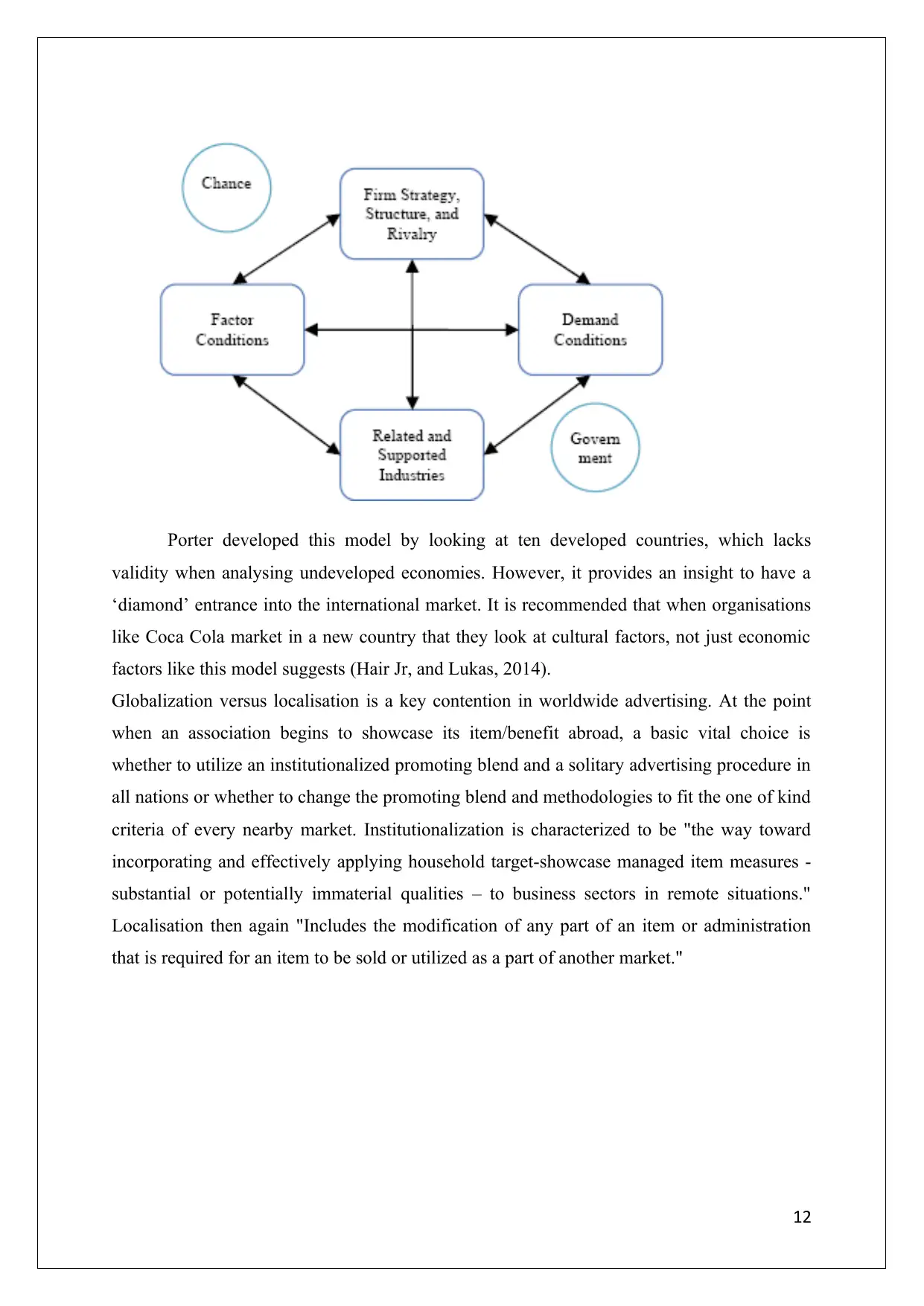
Porter developed this model by looking at ten developed countries, which lacks
validity when analysing undeveloped economies. However, it provides an insight to have a
‘diamond’ entrance into the international market. It is recommended that when organisations
like Coca Cola market in a new country that they look at cultural factors, not just economic
factors like this model suggests (Hair Jr, and Lukas, 2014).
Globalization versus localisation is a key contention in worldwide advertising. At the point
when an association begins to showcase its item/benefit abroad, a basic vital choice is
whether to utilize an institutionalized promoting blend and a solitary advertising procedure in
all nations or whether to change the promoting blend and methodologies to fit the one of kind
criteria of every nearby market. Institutionalization is characterized to be "the way toward
incorporating and effectively applying household target-showcase managed item measures -
substantial or potentially immaterial qualities – to business sectors in remote situations."
Localisation then again "Includes the modification of any part of an item or administration
that is required for an item to be sold or utilized as a part of another market."
12
validity when analysing undeveloped economies. However, it provides an insight to have a
‘diamond’ entrance into the international market. It is recommended that when organisations
like Coca Cola market in a new country that they look at cultural factors, not just economic
factors like this model suggests (Hair Jr, and Lukas, 2014).
Globalization versus localisation is a key contention in worldwide advertising. At the point
when an association begins to showcase its item/benefit abroad, a basic vital choice is
whether to utilize an institutionalized promoting blend and a solitary advertising procedure in
all nations or whether to change the promoting blend and methodologies to fit the one of kind
criteria of every nearby market. Institutionalization is characterized to be "the way toward
incorporating and effectively applying household target-showcase managed item measures -
substantial or potentially immaterial qualities – to business sectors in remote situations."
Localisation then again "Includes the modification of any part of an item or administration
that is required for an item to be sold or utilized as a part of another market."
12
⊘ This is a preview!⊘
Do you want full access?
Subscribe today to unlock all pages.

Trusted by 1+ million students worldwide
1 out of 22
Related Documents
Your All-in-One AI-Powered Toolkit for Academic Success.
+13062052269
info@desklib.com
Available 24*7 on WhatsApp / Email
![[object Object]](/_next/static/media/star-bottom.7253800d.svg)
Unlock your academic potential
Copyright © 2020–2025 A2Z Services. All Rights Reserved. Developed and managed by ZUCOL.



